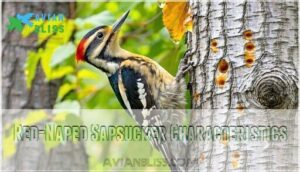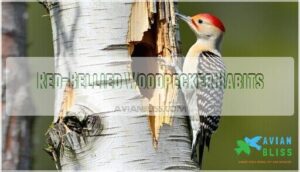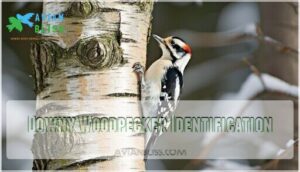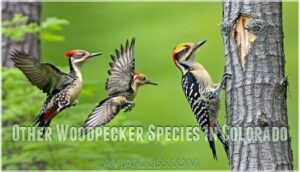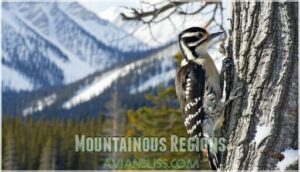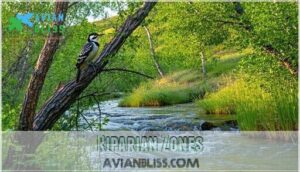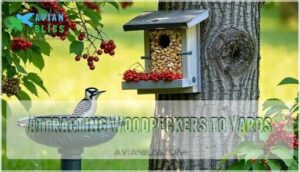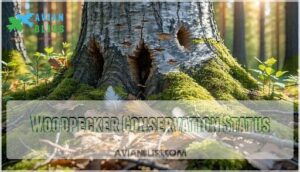This site is supported by our readers. We may earn a commission, at no cost to you, if you purchase through links.
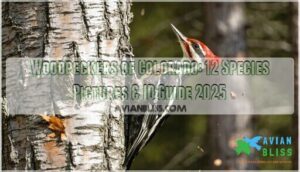
From the tiny Downy Woodpecker tapping on aspen bark to the bold Northern Flicker’s ground-foraging antics, Colorado’s diverse habitats support an impressive variety.
The Red-naped Sapsucker drills neat rows of holes for sap, while the striking Pileated Woodpecker creates rectangular cavities that sound like construction work.
These feathered carpenters thrive in everything from mountain forests to desert scrublands, adapting their feeding strategies to local conditions.
Whether you’re a backyard birder or serious ornithologist, Colorado’s woodpecker diversity offers endless observation opportunities.
The identification secrets and behavioral quirks ahead will transform every woodland walk into a treasure hunt.
Table Of Contents
- Key Takeaways
- Colorado Woodpecker Species
- Woodpecker Habitat Preferences
- Woodpecker Diet and Feeding
- Attracting Woodpeckers to Yards
- Woodpecker Conservation Status
- Frequently Asked Questions (FAQs)
- What is the most common woodpecker in Colorado?
- Is it good to have woodpeckers in your yard?
- What kind of bird looks like a woodpecker in Colorado?
- What bird looks like a woodpecker but isn’t?
- What are the 11 species of woodpeckers in Colorado?
- Do woodpeckers live in Colorado?
- Are there woodpeckers in the Rocky Mountains?
- Are woodpeckers good to have in your yard?
- What Colorado woodpecker has a red throat?
- Are woodpeckers protected in Colorado?
- Conclusion
Key Takeaways
- You’ll identify 12 distinct woodpecker species across Colorado’s diverse habitats, from tiny Downy Woodpeckers in aspen groves to massive Pileated Woodpeckers creating rectangular cavities in mature forests.
- You can attract woodpeckers to your yard by installing suet feeders with tail supports, preserving dead trees for nesting sites, planting native berry-producing shrubs, and providing fresh water sources.
- You’ll distinguish between similar species by observing key features – Hairy Woodpeckers have longer bills and pure white outer tail feathers, while Downy Woodpeckers are smaller with black-barred white tail feathers.
- You’re contributing to conservation efforts when you participate in citizen science programs like eBird, as several Colorado woodpecker species face population declines from habitat loss and climate change.
Colorado Woodpecker Species
You’ll find 12 distinct woodpecker species calling Colorado home, each adapted to the state’s diverse ecosystems from desert floors to mountain peaks.
These remarkable birds showcase unique identification features, from the Red-naped Sapsucker’s distinctive head stripe to the Downy Woodpecker’s compact size and white-streaked back.
Each woodpecker species displays remarkable adaptations perfectly suited to Colorado’s diverse landscapes.
Red-Naped Sapsucker Characteristics
You’ll recognize the Red-naped Sapsucker by its distinctive red head stripe and yellowish belly.
This Colorado woodpecker shows remarkable nest reuse behavior, often returning to the same tree annually. Their migration distance varies by gender, with females traveling farther than males.
Key identification features include:
- Head Stripe: Bright red marking across the nape
- Diet Variety: Sap, insects, fruits, and berries
- Lifespan Record: Nearly five years for the oldest recorded individual
These woodpeckers thrive in mid-elevation forests throughout Colorado’s intermountain regions, making woodpecker identification easier for birders seeking Colorado woodpeckers in their natural woodpecker habitat.
Red-Bellied Woodpecker Habits
Red-Bellied Woodpeckers stand out among Colorado woodpeckers with their distinctive belly coloration and fascinating mating rituals.
These vibrant birds captivate with their colorful plumage and unique pair-bonding behaviors that last a lifetime.
These lifelong mates share hatching duties equally, with males incubating eggs at night while females take day shifts.
Their vocalizations include harsh rolling calls and drumming patterns that strengthen pair bonds.
You’ll find these territorial birds defending their Colorado habitat year-round, making them excellent subjects for woodpecker identification.
These woodpeckers rely on dead or decaying trees for nesting and survival.
Downy Woodpecker Identification
At first glance, you might mistake this pint-sized woodpecker for its larger cousin, but size comparison reveals the Downy Woodpecker’s compact frame.
Colorado’s smallest woodpecker species displays distinctive plumage variations that aid in woodpecker identification.
Key identification features include:
- White belly with black back featuring white streaks
- Males show red patch on head’s back
- Stubby, short bill compared to similar species
- Call identification reveals high-pitched "pik" notes
- Behavior patterns include foraging on smaller branches and twigs
Hairy Woodpecker Distinctions
While Downy Woodpeckers charm with their petite stature, Hairy Woodpeckers command attention through their robust build and distinctive features.
You’ll distinguish Hairy Woodpeckers from their smaller cousins by observing key physical differences and behavioral patterns that make identification straightforward.
| Feature | Hairy Woodpecker | Downy Woodpecker |
|---|---|---|
| Size | 9-10 inches long | 6-7 inches long |
| Bill Length | Long, chisel-like | Short, stubby |
| Tail Feathers | Pure white outer feathers | White with black barring |
| Foraging Behavior | Aggressive, loud drumming | Gentle, quiet pecking |
Hairy Woodpeckers are Colorado’s medium-sized bark foragers due to their size.
Hairy Woodpecker behavior includes territorial drumming that echoes through forests, while their diet focuses on larger wood-boring beetles than Downy Woodpeckers consume.
Hairy Woodpecker habitat preferences lean toward mature forests with substantial deadwood.
This Hairy vs Downy comparison reveals how Hairy Woodpecker identification relies on size, bill proportions, and aggressive foraging style across Colorado’s diverse woodpecker communities.
Other Woodpecker Species in Colorado
Beyond the common Colorado woodpeckers, you’ll encounter fascinating specialty species throughout the state.
Lewis’s Woodpecker stands out with its salmon-pink face and acrobatic fly-catching abilities, while the clown-faced Acorn Woodpecker creates impressive granary trees for winter storage.
These birds play a vital role in maintaining Colorado’s forest health by controlling insect populations.
- Lewis’s Woodpecker: Aerial insect hunter with distinctive pinkish-red coloring
- American Three-toed Woodpecker: High-elevation bark beetle specialist in burned forests
- Acorn Woodpecker: Communal species storing thousands of acorns in custom-drilled holes
Woodpecker Habitat Preferences
Colorado’s woodpeckers inhabit diverse ecosystems ranging from high-elevation coniferous forests to desert scrublands and riparian cottonwood groves.
You’ll find different species adapted to specific habitats, with some preferring dead Ponderosa pines while others thrive in mixed woodlands or open forest edges.
Forest Ecosystems
Colorado’s forests create the backbone for common woodpeckers, where tree diversity supports healthy populations.
Forest health directly impacts these Colorado birds through insect outbreaks that provide abundant food sources, while fire ecology shapes nesting opportunities across mountainous terrain.
| Forest Type | Dominant Woodpeckers | Key Features |
|---|---|---|
| Ponderosa Pine | Lewis’s, Northern Flicker | Large dead trees, open canopy |
| Aspen Groves | Red-naped Sapsucker, Downy | Soft wood, cavity-rich |
| Mixed Conifer | Hairy, Three-toed | Dense understory, beetle larvae |
| Riparian Forest | Red-bellied, Williamson’s | Cottonwoods, water access |
| Spruce-Fir | American Three-toed | High elevation, insect diversity |
Climate change increasingly affects woodpecker distribution patterns throughout Colorado’s diverse forest ecosystems.
Desert Landscapes
You’ll find desert woodpeckers in Colorado’s arid landscapes have developed remarkable adaptations for water scarcity.
These desert woodpeckers exploit insect abundance around cacti and shrubs, with some species utilizing cactus nesting sites.
Colorado’s southeastern deserts support specialized birdwatching opportunities where these resilient birds demonstrate unique survival strategies, making them fascinating subjects for Colorado birds enthusiasts exploring diverse ecosystems.
Some species, like the Arizona woodpecker, thrive in Chiricahua Mountains habitats.
Mountainous Regions
High-altitude woodpeckers in Colorado’s Rocky Mountains face extreme winter survival challenges.
These resilient High-Altitude Species like the American Three-toed Woodpecker thrive in subalpine habitats where forests experience frequent snowfall and temperature drops.
Forest Fire Impact creates new nesting opportunities in burned snags, while Climate Change alters traditional migration patterns.
Mountain woodpecker species adapt by storing food caches and developing thicker plumage for harsh conditions.
Riparian Zones
Riparian zones along Colorado’s streams and rivers create woodpecker havens where water availability supports lush riparian vegetation.
Lewis’s Woodpecker thrives in these cottonwood corridors, while Northern Flickers exploit the insect abundance found in decaying streamside trees.
These moisture-rich areas boost bird diversity through erosion control and create prime birdwatching Colorado opportunities for multiple woodpecker species.
Woodpecker Diet and Feeding
You’ll discover that Colorado’s woodpeckers have specialized feeding strategies that match their unique bill shapes and foraging behaviors.
These birds consume everything from tree sap and wood-boring insects to fruits and arthropods, with each species adapting its diet to seasonal availability and habitat requirements.
Sap and Insect Consumption
You’ll discover Colorado’s woodpeckers rely heavily on sap and insects for survival, with specialized feeding strategies that vary by species and season.
The rednaped sapsucker exemplifies this dual approach, creating systematic sap wells while opportunistically capturing protein-rich insects.
- Sap Nutritional Value provides essential carbohydrates and minerals during spring months
- Larval Consumption peaks during breeding season when protein demands increase substantially
- Seasonal Diet shifts from winter sap dependency to summer insect abundance
- Feeding Competition occurs at productive sap wells among multiple woodpecker species
Fruit and Berry Eating
Colorado’s woodpeckers enjoy nature’s candy throughout the year, with seasonal fruit availability influencing their dietary patterns.
These birds demonstrate remarkable fruit source preferences, from wild serviceberries to occasional orchard raiding adventures.
Their digestion efficiency allows them to extract maximum berry nutritional value from fruit-bearing plants across Colorado’s diverse landscapes.
| Woodpecker Species | Preferred Fruits | Peak Season |
|---|---|---|
| Red-Naped Sapsucker | Elderberries, serviceberries | Late summer |
| Red-Breasted Sapsucker | Wild cherries, huckleberries | Fall |
| Lewis’s Woodpecker | Acorns, pine nuts | Autumn |
| Northern Flicker | Sumac berries, dogwood | Year-round |
| Williamson’s Sapsucker | Mountain ash berries | Late fall |
The woodpeckers’ ability to thrive on diverse landscapes and their preference for specific fruits make them unique, with some species like the Northern Flicker enjoying year-round access to their preferred fruits.
Wood-Boring Insect Feeding
Beyond tree bark, Colorado woodpeckers excel at Insect Identification, targeting wood-boring beetle larvae with remarkable precision.
Their specialized Feeding Adaptations include barbed tongues and reinforced skulls for efficient Larval Consumption.
The Digestion Process breaks down tough insect proteins, while the high Nutritional Value of these insects supports their energy-intensive lifestyle throughout Colorado’s diverse forests.
Supplementing their diet with high-fat energy foods is essential for surviving cold weather.
Arthropod Consumption
While woodpeckers target wood-boring insects, their Arthropod Consumption extends far beyond beetles.
Colorado woodpeckers excel at Spider Predation, plucking arachnids from bark crevices with surgical precision.
Their Insect Foraging includes Ant Consumption, with species like Red-bellied Woodpeckers dedicating entire foraging sessions to ant colonies.
Larvae Preference drives their excavation behavior, while Seasonal Diet variations guarantee year-round protein sources for Colorado’s diverse woodpecker populations.
Attracting Woodpeckers to Yards
You’ll find that creating a woodpecker-friendly yard requires specific feeders and habitat features that cater to their unique feeding behaviors.
Install suet feeders with tail prop supports, preserve dead trees for nesting sites, plant native berry-producing shrubs, and provide fresh water sources to attract Colorado’s diverse woodpecker species to your backyard.
Suet Feeder Installation
Installing suet feeders correctly attracts Colorado’s diverse woodpecker species to your backyard. Strategic feeder placement and proper maintenance guarantee consistent visits from these fascinating birds.
Many options exist for purchasing quality feeders.
Consider these essential installation tips:
- Feeder Placement: Mount suet feeders 5-6 feet high on sturdy poles or tree trunks
- Squirrel Baffles: Install below feeders to prevent unwanted visitors from stealing suet
- Suet Types: Choose high-energy blends with insects, nuts, and seeds for superior nutrition
- Feeder Maintenance: Clean feeders monthly and replace suet regularly for woodpecker safety
Dead Tree Preservation
You’ll want to keep dead trees, or snags, standing whenever safety permits, as they provide essential snag habitat for Colorado woodpeckers seeking nesting sites.
These decaying giants offer abundant insect populations beneath their bark, while decomposition benefits create perfect conditions for excavating tree cavities.
Consider sealant for dead trees to prolong the life of the tree.
Dead trees support both bird conservation and natural forest regeneration processes, making them a crucial part of the ecosystem.
Native Plantings
Native plants create a backyard buffet that Colorado woodpeckers can’t resist, offering everything from Attracting Insects to Berry Production.
Choose species like serviceberry and chokecherry for Seed Sources, while aspen and cottonwood provide essential Nesting Materials.
You can find Colorado native plants for your backyard.
This Habitat Diversity transforms your yard into prime woodpecker real estate, supporting multiple native plants that enhance birdwatching in Colorado experiences year-round.
Birdbath and Fountain Installation
Beyond native plants, fresh water sources provide another powerful magnet for Colorado woodpeckers.
You’ll want to position birdbaths strategically near trees where these birds naturally forage. Choose durable fountain materials that withstand Colorado’s harsh winters, and maintain proper cleaning frequency to prevent disease transmission.
For added appeal, consider how fountain sounds create ambiance in your garden.
- Water Source Placement: Position birdbaths 3-10 feet from trees for quick escape routes while birdwatching
- Fountain Material Choices: Select freeze-resistant ceramic or concrete that survives Colorado’s temperature swings
- Birdbath Winterization: Install heated elements or change water daily to keep sources accessible year-round
Woodpecker Conservation Status
Colorado’s woodpecker populations face varying conservation challenges, with some species thriving while others experience significant declines that require immediate attention.
You’ll find that community science programs and habitat preservation efforts play pivotal roles in protecting these remarkable birds for future generations.
Protected Species in Colorado
Beyond attracting woodpeckers to your yard, Colorado’s legal protections safeguard several vulnerable woodpecker species.
Five species face significant population threats from habitat loss and environmental changes, requiring targeted conservation strategies and recovery programs to maintain stable populations.
Protecting these species is essential, as birds aid reforestation through seed dispersal.
| Species | Protection Status | Primary Threats |
|---|---|---|
| Red-naped Sapsucker | Protected | Habitat loss, climate change |
| Lewis’s Woodpecker | Protected | Habitat fragmentation, fire suppression |
| Williamson’s Sapsucker | Protected | Logging, habitat degradation |
| Black-backed Woodpecker | Protected | Fire management practices |
| Pileated Woodpecker | Protected | Forest clearing, habitat loss |
The protection of these species is crucial for maintaining stable populations and addressing the impacts of environmental changes.
Conservation Efforts and Initiatives
Across Colorado, woodpecker conservation relies on coordinated efforts spanning multiple organizations and funding sources.
State wildlife agencies implement species-specific management plans while nonprofit groups lead habitat restoration projects targeting critical ecosystems.
Key Conservation Initiatives:
- Population Monitoring – Tracking species like Lewis’s woodpecker, which declined 60% since the 1960s
- Habitat Restoration – Reforestation projects and invasive species removal in forest ecosystems
- Community Engagement – Educational programs promoting woodpecker-friendly yard practices and stewardship
- Policy Impacts – Legislation protecting nesting sites and regulating forestry practices affecting habitats
- Funding Sources – Grants supporting research on climate impacts and land use changes affecting wildlife
Community Science and Monitoring
You can join thousands of Colorado birdwatchers contributing to eBird monitoring and other citizen science programs.
These volunteer assessments provide essential data analysis for tracking woodpecker populations across the state.
Your observations through platforms like iNaturalist help scientists understand species distribution and breeding patterns.
This community-driven approach creates real conservation impact for Colorado’s woodpecker species, and by doing so, it supports citizen science programs, which are crucial for understanding species distribution.
Habitat Preservation and Restoration
Habitat preservation protects Colorado’s woodpeckers through Forest Management practices that maintain dead trees for nesting.
Reforestation Efforts expand suitable forests, while Wetland Conservation supports riparian species.
Urban Habitats require native plantings and reduced pesticide use.
Climate Change threatens mountain forests, making habitat preservation essential for woodpecker survival across Colorado’s diverse ecosystems.
Frequently Asked Questions (FAQs)
What is the most common woodpecker in Colorado?
Which Colorado woodpecker drums most frequently on your roof? The Northern Flicker takes the crown as the most troublesome species, causing the majority of woodpecker-related property damage statewide.
Is it good to have woodpeckers in your yard?
Yes, woodpeckers benefit your yard by controlling insect pests like beetle larvae and wood-boring bugs. They’re natural pest controllers that keep trees healthy, though they might occasionally drum on houses.
What kind of bird looks like a woodpecker in Colorado?
Several birds resemble woodpeckers in Colorado, including nuthatches, which creep down tree trunks headfirst, and brown creepers that spiral up bark searching for insects with their curved bills.
What bird looks like a woodpecker but isn’t?
Absolutely mind-blowing mimicry occurs when you spot nuthatches.
These clever birds walk headfirst down tree trunks, tap bark for insects, and share woodpeckers’ tree-hugging lifestyle, but they’re completely different species with shorter bills.
What are the 11 species of woodpeckers in Colorado?
You’ll find these eleven woodpecker species throughout Colorado’s diverse habitats: Red-naped Sapsucker, Acorn Woodpecker, Hairy Woodpecker, American Three-toed Woodpecker, Red-headed Woodpecker, Williamson’s Sapsucker, Northern Flicker, Red-bellied Woodpecker, Ladder-backed Woodpecker, Downy Woodpecker, and Lewis’s Woodpecker.
Do woodpeckers live in Colorado?
Colorado hosts twelve woodpecker species that thrive in diverse habitats from deserts to mountain forests. You’ll spot common ones like Northern Flickers and Downy Woodpeckers year-round across the state.
Are there woodpeckers in the Rocky Mountains?
Yes, you’ll find woodpeckers thriving throughout the Rocky Mountains! These mountains provide perfect habitat with diverse forests, from aspen groves to pine stands, supporting multiple species year-round.
Are woodpeckers good to have in your yard?
Imagine this: your yard’s tiny pest control squad working 24/
Woodpeckers excel at eliminating harmful insects like carpenter ants, wood-boring beetles, and larvae that damage trees.
They’re natural exterminators that protect your landscape.
What Colorado woodpecker has a red throat?
Red-breasted Sapsuckers sport vibrant red throats and chests, making them easy to spot in Colorado’s forests. You’ll also find them drilling neat rows of holes to collect sap from trees.
Are woodpeckers protected in Colorado?
Like opening your front door, you’ll need a special key here.
Woodpeckers are protected by federal and state laws across Colorado, making lethal removal illegal under protection acts that safeguard these valuable birds.
Conclusion
Mastering identification of Colorado’s woodpeckers transforms every outdoor adventure into an exciting discovery mission.
You’ll now recognize the Red-naped Sapsucker’s methodical sap wells, distinguish between Downy and Hairy woodpeckers by size, and spot the Pileated’s massive rectangular excavations.
These woodpeckers of Colorado thrive across diverse ecosystems, from alpine forests to desert washes.
Your enhanced knowledge empowers you to contribute valuable observations to citizen science projects while enjoying these remarkable birds in your own backyard.
- https://extension.colostate.edu/topic-areas/natural-resources/preventing-woodpecker-damage-6-516/
- https://cnhp.colostate.edu/download/documents/cwic_docs/CPWSpeciesProfiles/CPWProfiles_LewissWoodpecker.pdf
- https://www.fcgov.com/naturalareas/pdf/understanding-flickers.pdf
- https://www.allaboutbirds.org/guide/American_Three-toed_Woodpecker/lifehistory
- https://www.centralcoloradoconservancy.org/specialprojects

